
I just want to play!
Why gamified learning increases employee motivation
How can organisations incorporate gamified learning to build the skills of their employees? In our digital world, organisations are more likely to invest in e-learning but are often challenged by low completion rates. Therefore, content needs to be taught in a playful way! We checked with some experts how this can work especially in Australia.

Our play instinct
When it comes to the concept of play, we usually think about the interactions of children. A child’s imagination is not the limit of play. This is demonstrated by the Latin term “homo ludens” which means “the people playing”. Our play instinct is very pronounced, regardless of how old we are. This is because games offer us a world of fun and creativity. We mostly play in a digital context in the modern world, and institutions and companies alike can take advantage of this through gamified learning.
A recent government study of Australian higher education students² found that only 46.6% of online students completed their qualifications. For face-to-face students, this is 76.6% by comparison. These statistics are problematic, because if learners fail to gain knowledge, then both time and money are wasted. It is vital that we present e-learning content in a playful way.
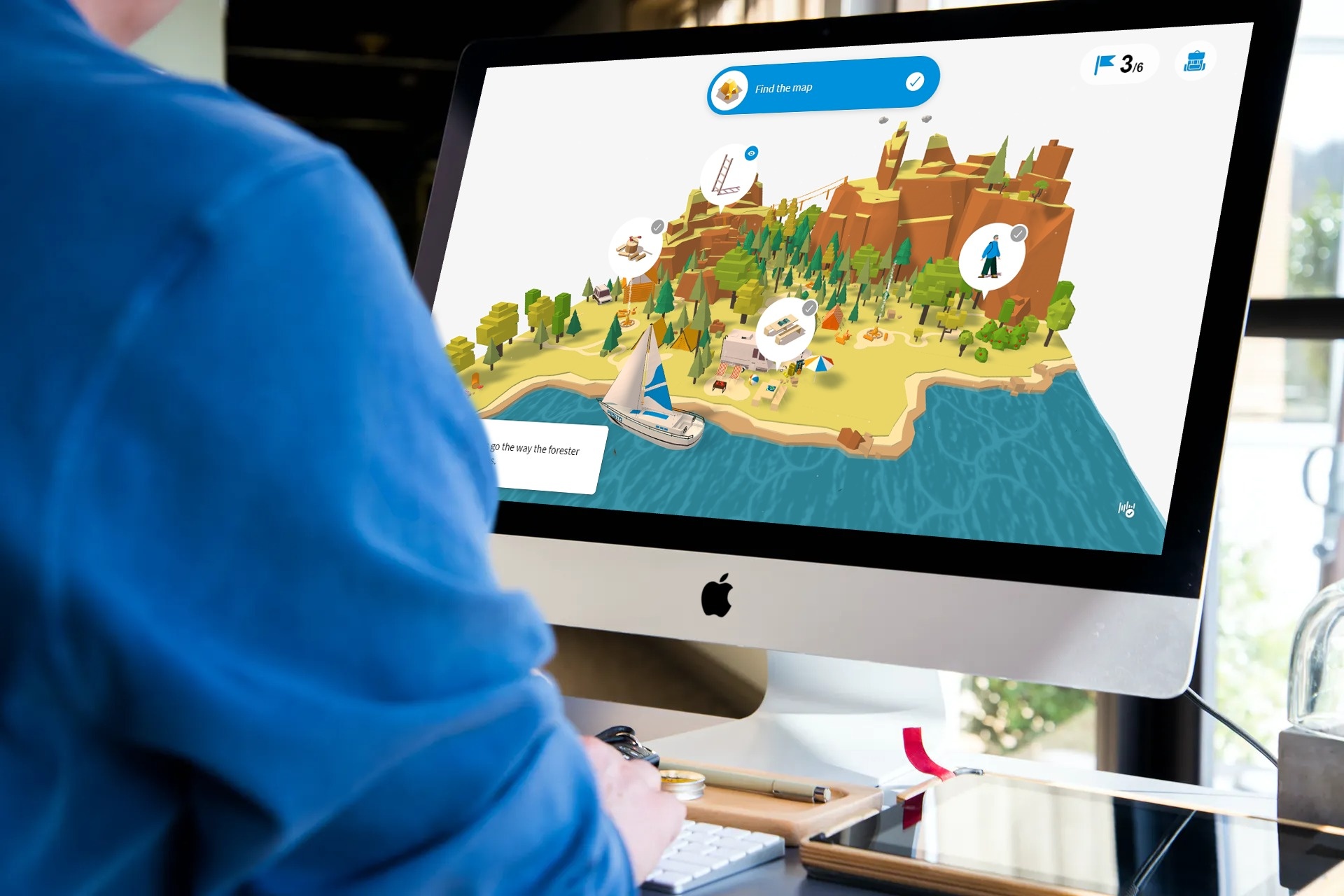
It’s time to get serious
Another sub-category of serious games is digital education games and gamified learning. Their primary focus is to impart knowledge. There are three types of serious games, these are:
Drill and practice games
The classic knowledge building games apps develop to build vocabulary or mathematic skills.
Quiz games
The BizQuiz app from imc is an example in which employees and entire teams can take part in engaging quizzes.
Point and click adventure games
Roleplaying games with enriched content and an exciting narrative.
The "City of Goods"

Learning through experience
The psychological benefit of gamified learning
Intrinsic
Extrinsic
Gamification is embedded in our everyday life. This can be through motivational tactics such as benchmarking (calorie or step counters) and nudging (such as point systems).
In summary, your employees are more likely to be motivated through gamified learning, when it is applied playfully.
Educational games can help reduce dropout rates and help employees build their skills in the workplace. Therefore: Game on!
This blog article is an extract from an article written by Sven R. Becker (A board member of imc AG) and Stephan Urbanski (Senior Instructional Designer at imc AG).
The original article was published in the I+MIO e-magazine (Available in German only).

Go for Game-based Learning
We talk about what lies beneath the trend of this playful knowledge transfer method. We explain why it works so well and present 3 application scenarios for game-based learning in the company.

Training soft skills with serious games
Softskills are more important than ever. But how to train them? imc's research team dealt with this challenge in the DEVELOP research project.
Contact


Digital Learning Journey: I am packing my suitcase. What I take along...
The key items one should never forget on a digital learning journey
Dear E-Learning Punk friends, one year of corona, one year without a holiday. Do you remember back when it was possible to travel the world with ease?
Cocktail in one hand, a good book in the other. Feet in the sand, sun on your face, looking at the roaring sea. That’s how many of us remember the perfect holiday. But there are many other ways to travel: From city breaks through backpacking tours to cruises, there’s something for everyone. The same applies to a learning journey.
What exactly do you need to pay attention to when planning, preparing and going on this journey? Over a nice cocktail, we asked travel guide and expert Eva Lettenbauer to offer some tips and hand you a checklist.

Planning a learning journey – What’s the destination?
Am I going on to explore far-flung places, or do I return to the little finca at the edge of the fishing village in Mallorca? We often go into holiday mode as soon as we start planning our trip. But we do have to decide on the destination.
Similarly, we need to figure out what digital training is meant to achieve for the company. What corporate goals is the training geared towards? What performance goals are being pursued? What exactly do we want to bring across? Should the training focus on background knowledge? Practical application? Sharing experiences? The more clearly you can define where you want to go with this journey, the more effectively you can leverage the different learning formats.

Everyone goes at their own pace on holiday. One person might want to see all of Paris in a day, while the next person would rather watch the hustle and bustle while sitting in a street café in Montmartre. But in the end, both want to take a picture in front of the Eiffel tower.
Defining the goals – the destination – and the contents of a training course is crucial for the success of a learning journey, but so is taking account of the actual learners. They are the target group the learning offers need to be tailored to. If employee requirements are met, they learn more efficiently and learning success is achieved more effectively. Learners should be enabled to close their knowledge gaps to the best of their abilities and learn at their own pace.
Packing the suitcase – What are the essentials?
Finally, the time has come! A quick check to see if last year’s bikini still fits and the sunscreen hasn’t hardened up. Now to the evening outfits – What can I wear when it gets cooler at night? Hang on. Does it even cool down in Bali?
Packing the right stuff for my destination is important. The same applies to training objectives: Each format is suitable for a range of contents and has its own advantages. Virtual classrooms are great for exchanging ideas, while web-based training helps participants to learn theoretical content at their own pace. By packing the right formats, you create a learning journey. This also opens up the opportunity to create small, digestible learning nuggets that are easy to integrate into day-to-day work.

Shoes, clothes, cosmetics, books and, of course, my sunglasses land in my suitcase.
For a learning journey that means the individual modules are defined. You might pack a virtual classroom, game-based learning, on-the-job challenges, social learning, quizzes and fill each with suitable content.
For imc customers, Eva Lettenbauer handles that part. She is a specialist for learning experience design at imc and turns contents into learning content. Above all, the learning journeys she thus creates motivate and aim to activate the learners.
“You want to capitalise on the strengths of each format and cater to different requirements and levels,” says Eva. “Depending on the level, advanced employees might even skip simpler topics. The better the modular system, the more flexible it is, allowing you to tailor it to the specific demands of each learner.”

Let the journey begin
Finally arrived and checked in. A quick look around the hotel, then I’ll see what I can reach on foot. Each journey has different stages. I need to get my bearings before I party in the best club in town with the locals without sticking out as a tourist. ¿Quién sabe? Maybe I even speak a few words of Spanish by the end of my trip?
The learning journey also goes through different stages. First, the learner needs to find their way around. A brief introduction helps to set the tone for the topic and motivate the learner. Then, the theoretical foundation is created as the necessary knowledge is gained. In the next step, the learned material is applied – on-the-job challenges, job aids, tests in quiz format and, of course, social learning can be leveraged to achieve this stage goal. Finally, it all has to be internalised to reach the end of the journey. From this point onwards, the learner can also act as a mentor and support others in their development.

Checklist
The best thing about the travel guide I used for my last holiday was the checklist for must-do sights and experiences in the city. To equally help your digital learning journey become a resounding success, we offer this checklist:
- Define objectives and content
- Distribute content across suitable formats
- Introduce the learner to the training and motivate them
- Create a theoretical foundation
- Apply the knowledge on the job
- Establish an active, self-directed learning culture
Now, we are just as excited about learning journeys as we are about travelling.
Of course, you won’t have to wait long for the next edition of E-Learning Punk, either. We will be all be about the intriguing topic of gamification.
... and if you’re still looking for the right holiday read: We’ve got that covered as well.
![[E-Learning Punk] Exploratory 3D Learning](https://images.im-c.com/wp-content/uploads/2021/02/imc_image_elearningpunk_3Dlearning_hero.jpg)
Exploratory 3D Learning
Not only movies like “Avatar”, but also learning content can benefit from spatially compelling images. We explain the advantages of this professional development trend and present you application scenarios for 3D learning.

Immersive Learning during the Crisis
Immersion is one of the most successful learning methods. Jennifer Fritz, VR expert, points out the potential benefits of using Virtual Reality especially during this unprecedented times.
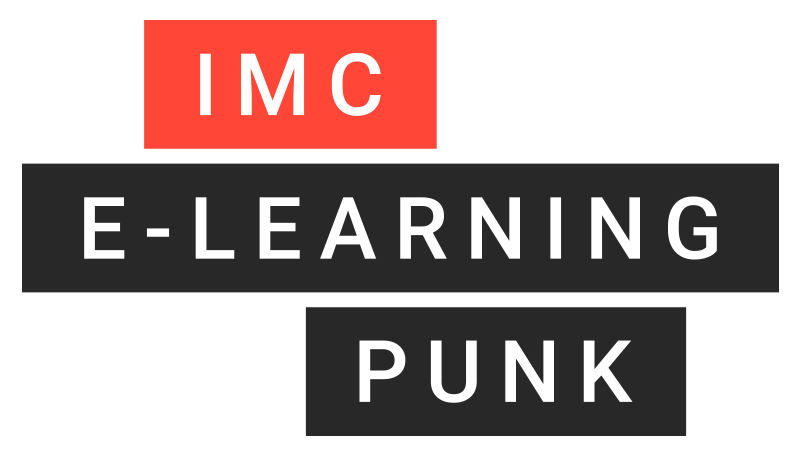
Contact person
I joined the imc newsroom team in 2021. As a journalist my heart beats for content and storytelling.
I’m excited to figure out how e-learing and digitization affect the future of work. My task is to create content to talk about and I’m always looking for trends.
Privately I love to travel and eat Tapas.
Topics: E-Learning Trends, Corporate Social Responsibility, Press and Influencer Relations
![[E-Learning Punk] Exploratory 3D Learning](https://images.im-c.com/wp-content/uploads/2021/02/imc_image_elearningpunk_3Dlearning_hero.jpg)
Exploratory 3D Learning
Spatial depth brings profound changes to the world of professional development

Digital 3D professional development
Maximum educational value x3
- Interactive and exploratory learning in virtual space
- Independent exploration of a visually appealing world
- Experiencing the immediate consequences of actions
Application scenarios for 3D Learning x3
Onboarding
In large corporations, a 3D map can provide initial orientation to the various corporate divisions which are displayed on a kind of city map, for example.
Product training
A 3D map makes it possible to vividly present products and services to clients, partners and employees in virtual showrooms – and not only during lockdown. AR spots make the integration of virtual and physical worlds turn out particularly well.
Security training
3D Map supports efficient training for appropriate behaviour in crisis scenarios such as a fire in the building.
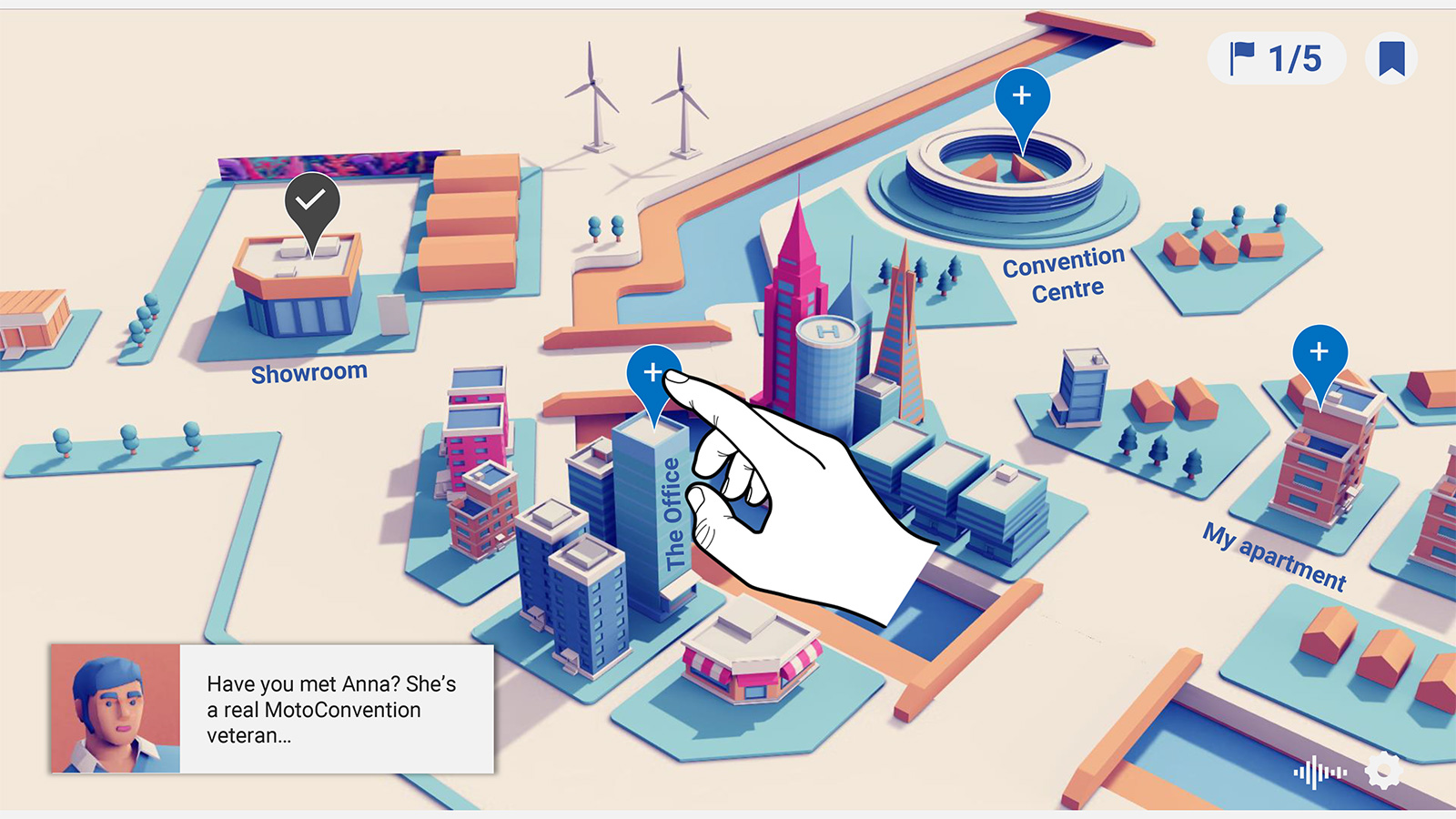
Another concrete example for the use of the imc 3D Map is a virtual world called "Moto City".
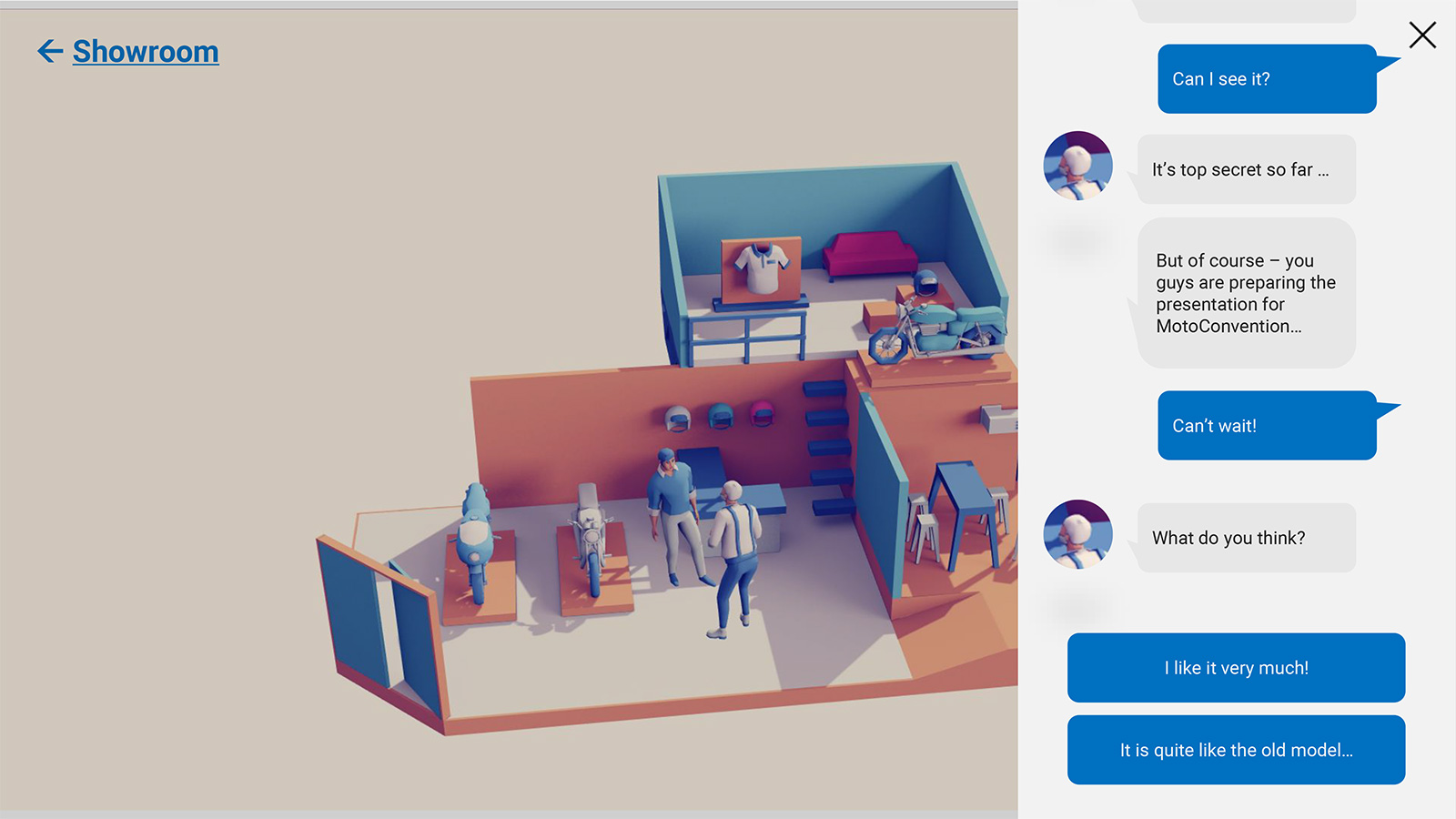
Another concrete example for the use of the imc 3D Map is a virtual world called "Moto City".

Another concrete example for the use of the imc 3D Map is a virtual world called "Moto City".
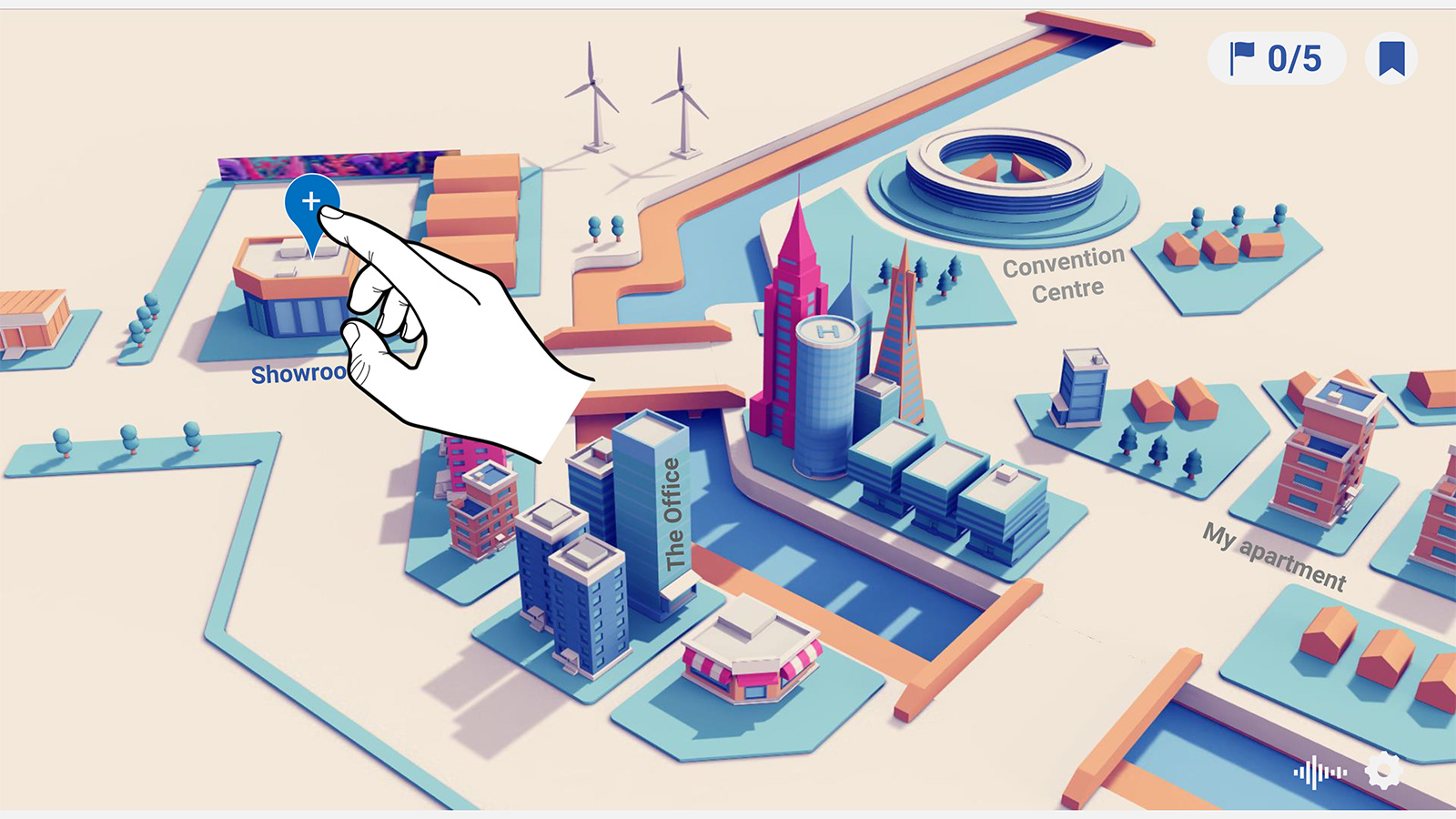
Another concrete example for the use of the imc 3D Map is a virtual world called "Moto City".

Another concrete example for the use of the imc 3D Map is a virtual world called "Moto City".
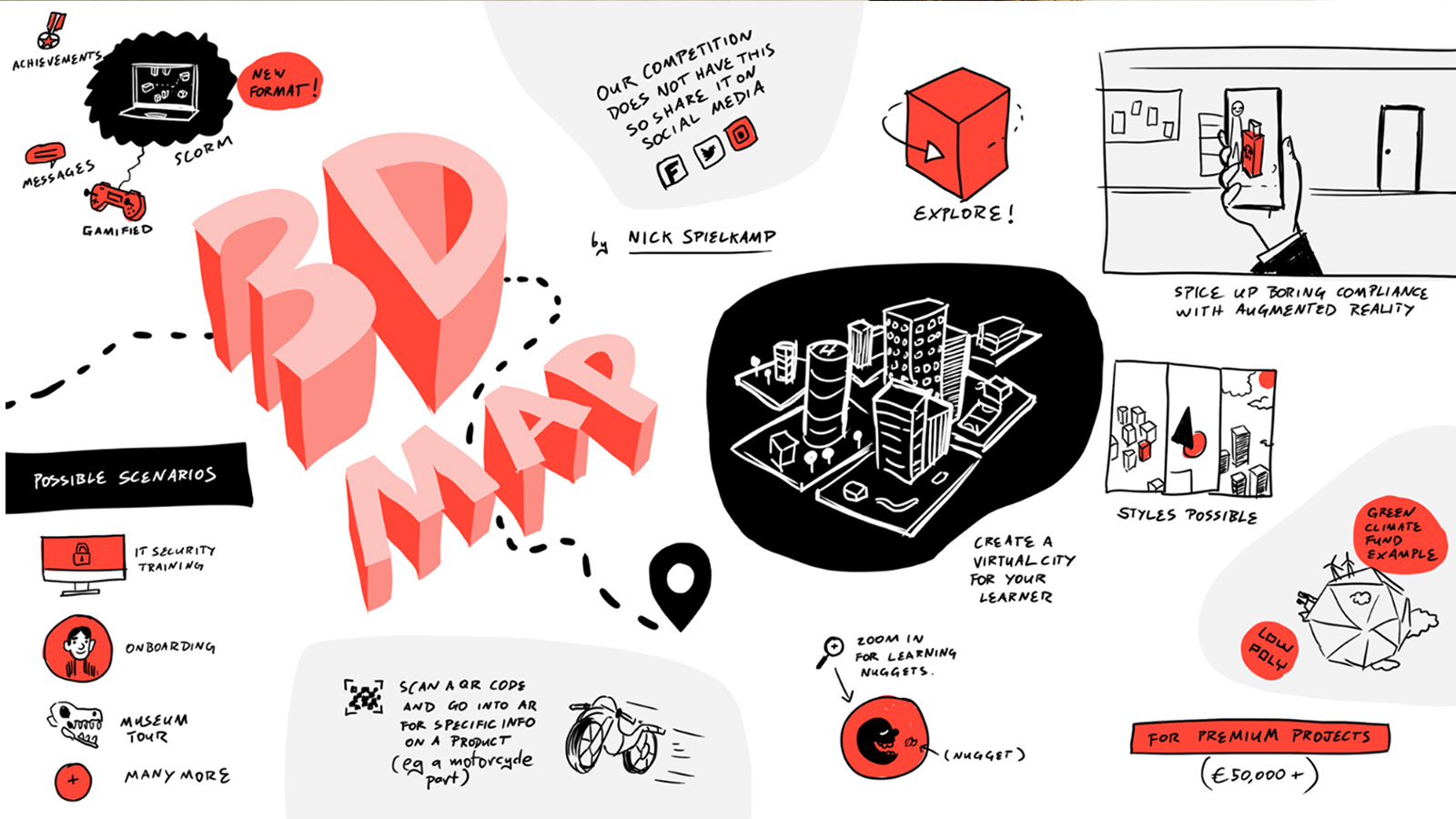

Contact person

e-learning content
E-Learning Punk
You want to stand out from the grey mass of boring web-based trainings (WBTs) and inspire your learners with cool, creative and engaging content? Then you've come to the right place! E-Learning Punk is an article and talk series for all L&D Pros who want to dare something and believe that digital training has to be colourful and loud.
E-learning's not dead. It's time for
Every day new trends in digital training emerge - from game-based learning to mobile learning.
Every month we present a trend in an article, explain and give suggestions and tips on how to implement it in the company.
Every three months, we also discuss the latest and greatest of the last few months with experts in a talk session.

Articles

Cohort-based Learning: Learning Together Beats going it Alone
What does cohort-based learning mean? And why beats learning together going it alone? We have the answers! Learn more...

Leadership Training: When the Boss Takes the Learner’s Seat
Today’s managers are expected to have both subject expertise and good people skills. Subject expertise can be learned, obviously, but what about the people stuff – the soft skills?

Engaged Learning Through Learning Campaigns
In the same way, a good learning campaign should bring about a mind shift – ideally one that leads to concrete action. Sounds good, but how exactly? The answer is portals. They can provide a highly effective entry point to learning campaigns.
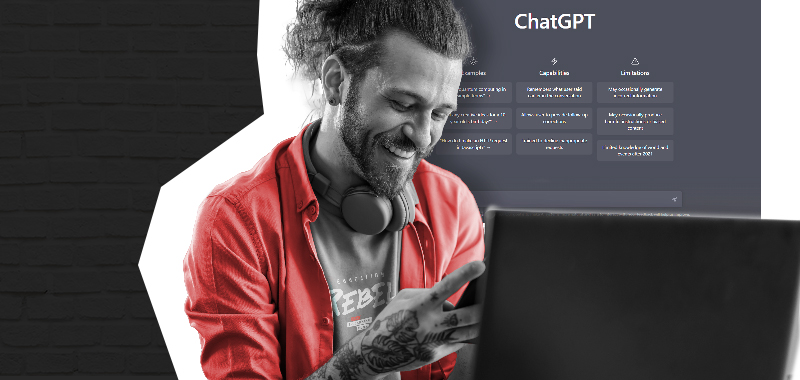
Hype or future: Will ChatGPT revolutionise corporate learning?
Hype or future: We have a look at what ChatGPT means for Corporate Learning

How Tinder and Netflix are shaping the future of learning
In a challenging environment, corporate learning will remain effective only if it is learner-centric and offers formats that are in keeping with learners’ other everyday digital experiences. This is important because learning providers are no longer competing just with other learning providers; they are also competing with dating apps, streaming services and social media.

Using Improvisational Theatre for Corporate Learning
Improv theater accomplishes what is expected of many teams on the job: they move safely through an uncertain situation by constantly adapting to new challenges, relying on each other, and acting spontaneously together. So it makes sense to use the method of improvisational theater in corporate learning as well.

Off-the-shelf content has come a long way from being an uncomfortable compromise
Individual or standard content - which should you choose? You should first ask yourself, "Is the training need or problem I have very specific? Or is it something that many different people in different industries need training on?"

The Power of Emotionally Intelligent Brand Training
Emotionality makes it easier for employees to identify with the brand. This identification has a positive effect on motivation and thus directly on daily work. Emotional brand training also generates brand ambassadors from within the company.

Diversity in e-learning content
Diversity in e-learning is clearly growing in importance. So, in this article, we have put together a summary of key recommendations for companies seeking to incorporate diversity into their learning experience.
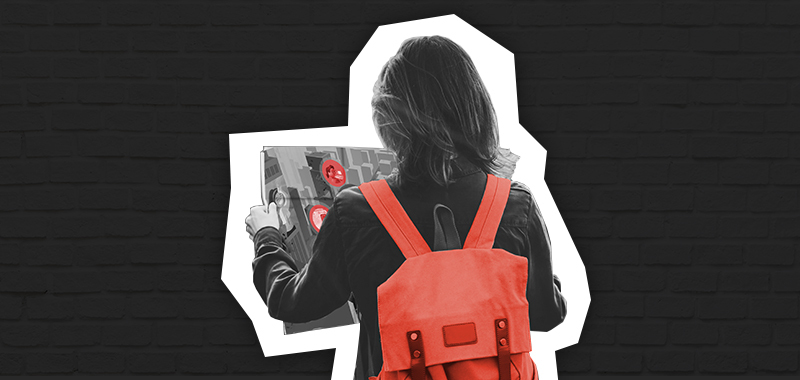
Tips and Tricks for Using 2D Maps in Learning Design
2D cards are old hat? No! We explain the difference between a 2D and a 3D map and show the structure of a 2D map training and its advantages.

E-Learning Content Trends 2022
Out with the old, in with the new. A new year brings new content trends that nobody involved in corporate learning can afford to ignore. Together with Falk Hegewald, Director E-Learning at imc, we are taking a look at the coming year’s crucial topics for companies.
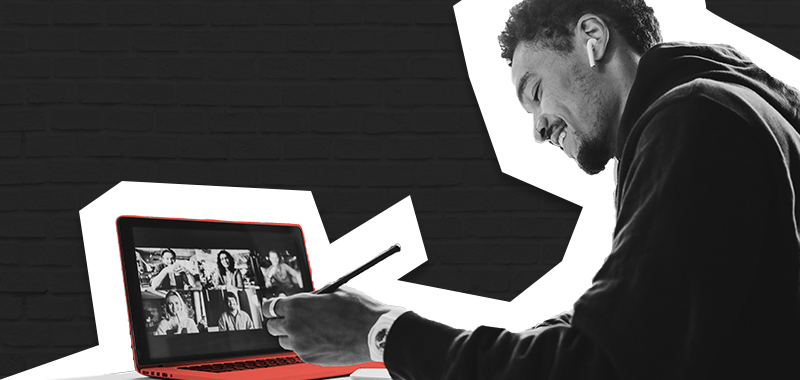
Six vital modules for every digital onboarding concept
This concept turns new content and existing e-learning content into an exciting and creative digital onboarding, even without a learning management system (LMS).

Rapid Content Development
Sometimes things have to happen quickly: This also applies to the creation of digital training. We check why fast creating digital trainings is possible but risky.

Gamification takes corporate learning to a new level
The fact that Game Based Learning works as a motivational booster for e-learning is already rooted in childhood. We have summarized the most common types of games and practical examples of possible applications for you.

Digital Learning Journey
Reaching the destination with the right blend of formats: Digital learning journeys capitalise on the strengths of each learning format to create a motivating and activating learning experience.
![[E-Learning Punk] Exploratory 3D Learning](https://images.im-c.com/wp-content/uploads/2021/02/imc_image_elearningpunk_3Dlearning_thumbnail.jpg)
Exploratory 3D Learning
Not only movies like “Avatar”, but also learning content can benefit from spatially compelling images. We explain the advantages of this professional development trend and present you application scenarios for 3D learning.

Learning with GIFs
Social media is not the only place for GIFs. They can also make learning more vivid and entertaining. We have compiled the most important arguments as well as some tips for the use of GIFs in e-learning for you.

A plea for diverse learning content
Diversity is increasingly becoming a hygiene factor in our working world. E-Learning Content Project Manager Kenny appeals: “The diversity you want must also be reflected in your learning content.”
![[E-Learning Punk] Digital Fastfood](https://images.im-c.com/wp-content/uploads/2020/07/imc_image_elearningpunk_DigitalFastfood_thumbnail_2020_07_07.jpg)
Digital rebellion or digital fastfood?
During the corona crisis companies are catapulted into the digital future. But how much of the current digitalisation efforts in professional development are really sustainable?
![[E-Learning Punk] Virtual Classroom Preview](https://images.im-c.com/wp-content/uploads/2020/06/imc_image_elearningpunk_virtualclassroom_thumbnail_2020_06_05.jpg)
Rock 'n' roll in the virtual classroom
Virtual lessons are on the rise. Find out how the virtual instructions work, what you should pay special attention to and which providers offer virtual classrooms software.

Social Learning While Social Distancing
Social learning is among the top e-learning trends in times of corona and social distancing. Discover three social learning scenarios in the business context and pick up specific tips for realising them.

Immersive Learning during the Crisis
Immersion is one of the most successful learning methods. Jennifer Fritz, VR expert, points out the potential benefits of using Virtual Reality especially during this unprecedented times.

AI Learning
"Artificial intelligence is already further than critics believe." imc board member Dr. Wolfram Jost explains in this interview how far AI actually is using illustrative examples.

The quiz show phenomenon in e-learning
Quiz apps for learning? For sure! We will talk about the success factors of quizzes, introduce areas of application for quiz apps in companies and give you 5 tips for their use in continuing education.

Watch out: Video-based Learning
You'll get to now the benefits of video learning and five major training video formats. Finally, you woll get tips on how to create training videos.

Go for Game-based Learning
We talk about what lies beneath the trend of this playful knowledge transfer method. We explain why it works so well and present 3 application scenarios for learning games in the company.

Mobile Learning Life-Hacks
Smartphones, Twitter & Co. are already part of our everyday lives. With our life-hacks you will create inspriring and engaging content that your team can consume from anywhere.

Blended Learning Recipe
Blended learning is like a balanced meal. In our interview instructional designer Malte Arends reveals his recipe for perfect blended learning, every time.
Talk sessions

Punky Talk #5: Sven R. Becker
Instead of focusing on trends, our E-Learning Punk 2020 Festive Season Special takes a closer look at the e-learning basics: What are the fundamentals companies need to have in place before they can focus their efforts on the latest digital professional development trends? Sven R. Becker, Member of the Board of imc, reveals how to build a solid foundation.

Punky Talk #4: Dr. Fabian Kempf
Dr. Fabian Kempf is Managing Directors of Vitero, a virtual classroom tool provider. The highlight of the Vitero software is its user interface which depicts a virtual room based on the real world. Yet, Dr. Kempf is not a fan of poorly modelled 3D avatars. Find out why.

Punky Talk #3: Katharina Kunz
Katharina, an expert for learning strategies, helps companies link learning content, systems and people to create a working learning ecosystem. She is appealing to those in charge of professional development to provide their learning offer in buffet form.

Punky Talk #2: Roman Rackwitz
Roman Rackwitz has been involved in gamification since 2007 and has already been named one of the top 10 gamification experts in the world. In the E-Learning Punky Talk, he discusses game-based learning, quiz-based learning and AI.

Punky Talk #1: Karlheinz Pape
In this E-Learning Punk Talk, Karlheinz Pape, founder of the German Corporate Learning Community, talks about his favourite topic, self-directed learning, as well as the current digital training trends video-based learning, blended learning and mobile learning.
Like. Follow. Share.
Discuss e-learning trends with us and become part of our lively and interactive social media world. Choose your channel and off you go: tweet, like, post, discuss, share and recommend.
Under the hashtag #eLearningPunk you can find all articles and videos of the series. You can also use the hashtag to post and discuss questions to our talk guests.
Contact person
I joined the imc newsroom team in 2021. As a journalist my heart beats for content and storytelling.
I’m excited to figure out how e-learing and digitization affect the future of work. My task is to create content to talk about and I’m always looking for trends.
Privately I love to travel and eat Tapas.
Topics: E-Learning Trends, Corporate Social Responsibility, Press and Influencer Relations, New Work
I am always happy to receive feedback on the series at [email protected]


Five tips for more fun with e-learning
The company is offering a new e-learning course – does this still have the unfortunate effect of triggering the same feelings in your learners as their annual reminder to have the plaque removed from their teeth? It doesn't have to! We'll give you tips and tricks on how to make learning more fun by using GIFs.
Basics on the topic of GIFs
The first GIF had already been developed as early as 1987, but the idea of GIFs goes back even further. GIFs are, in fact, comparable to the good old flip book. The rapid flow of several individually drawn graphics creates a moving image for the human eye, basically an extremely short video without sound.

Not quite picture, not quite video: GIF stands for Graphic Interchange Format. GIFs are usually animated short clips without sound.
Even after more than 30 years, GIFs still enjoy great popularity, despite their somewhat dated appearance. The popular moving images are widely used, pixelated and limited colour spectrum notwithstanding, because they can be integrated almost anywhere and are easy to create and share. What’s more: Our digital communications, whether on Twitter, WhatsApp or Teams, would certainly be a lot less entertaining and descriptive without GIFs. Speechless? No problem! Joy, sadness, compassion, shame – no matter what feeling you want to convey, you can always find a GIF for it.
Good reasons for using GIFs in learning
Social media is not the only place for GIFs. They can also make learning more vivid and entertaining. We have compiled the most important arguments for the use of GIFs in e-learning for you:
- GIFs visually represent ideas and information in a few seconds
- A GIF is easier to follow than a series of still images
- GIFs usually run in a loop and are also perceived out of the corner of the eye
- GIFs therefore do justice to the attention span of Generation Goldfish (<8 seconds)
- Creating GIFs is much easier than creating high-end video content
- GIFs play automatically on almost any system
- GIFs trigger emotions. The stronger the emotion, the better the memory
- GIFs are mobile-friendly and ideal for micro-learning
tips for more GIF Ingenuity
The use of GIFs in e-learning offers several advantages. Use these short, vivid clips, for example, to make a step-by-step tutorial more entertaining, reinforce a key message, provide feedback, or make comparisons. We have summarised the most important tips for using GIFs in digital training courses for you below:
Tip 1: Offer your goldfish entertainment
Technological progress brings many opportunities and possibilities along with it, but at the same time, it is blamed for decreasing attention spans. You can counter that with GIFs. A good GIF attracts attention and triggers emotions, thus ensuring long-term retention. Boring, colourless GIFs reduce these effects.

Tip 2: No information overload
A rule of thumb should be: Only one theme per GIF. The individual short clips should not be longer than ten seconds and should be intuitively comprehensible. After all, true GIF genius is about explaining even complex facts in a simple and entertaining way (see point 1!).

Tip 3: Don't become Robin Hood. Or: No stealing for a good cause
Besides the popular genre of animal GIFs (keyword cat content), ultra short film scenes make particularly popular GIFs. Before you use a GIF like this from the Internet for your online training courses, however, make sure that you are not violating any copyrights.

Tip 4: Not everyone is familiar with Harry Potter
Consider the cultural background and age of your target audience. For example, if you use a meme from a film, ask yourself: Is my target audience likely to know the film? If a GIF is not clear and understandable, its positive learning effect is significantly reduced.

Tip 5: And the Oscar goes to... Hire a good protagonist
Do you have a recurring character in your other online training courses? Then provide your learners with a common thread and create GIFs with that character as well, for example, to provide feedback on a digital query. Passed the test? -> Rejoicing & Applause. Didn't pass the test? -> Sad face.

During an in-house imc BarCamp, Instructional Designer Stephan Urbanski and Senior Developer Frédéric Macchi presented a more detailed look at the potential of GIFs in the context of learning. The following sketchnote summarises the results of the session and all the important facts about learning with GIFs:
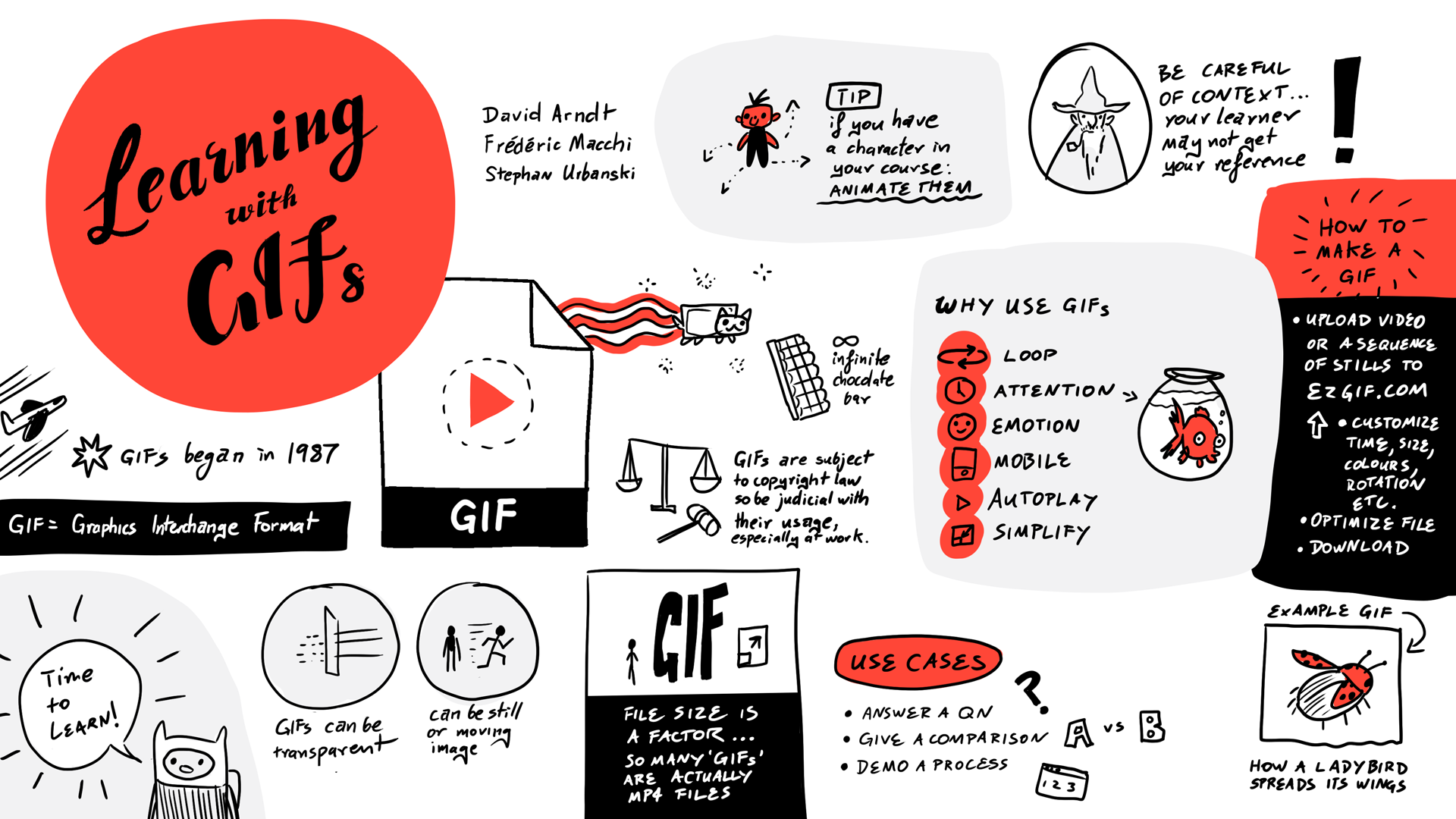
Contact person

![[E-Learning Punk] Christmas Special](https://images.im-c.com/wp-content/uploads/2020/12/imc_image_elearningpunk_Christmas_hero_2020_12_17.jpg)
Punky Talk #5: Sven R. Becker
The imc Board Member talks about basics like learning culture and target group orientation
Our fifth Punky Talk is our 2020 Festive Season Special. As a one-off, it is dedicated to the e-learning basics rather than to trends. After all, countless lists of top trends for the coming year are popping up wherever you look. We would rather use the year-end to ask: What are the fundamentals companies need to have in place before they can focus their efforts on the latest digital professional development trends in 2021?
And who is better placed to answer this question than Sven R. Becker? Sven was appointed to the Management Board of imc in January 2019 after many years of service for the company. During his studies, Sven already worked intensively on e-learning and UX design. Having paid close attention to the developments in the industry for years, he noted: 2020 was not just the year of corona, but also the big moment for “digital literacy”. A digital mindset now exists pretty much everywhere. Consequently, the relevance of e-learning is no longer limited to large corporations and companies in heavily regulated industries.
Sven recommends that anyone seeking to venture into the digital professional development world in the new year take an iterative approach. The important thing now is to get started! When trying to decide whether or not a trend is useful for your company, Sven suggests taking a closer look at the target group.
Sven also talks about costs, grassroots movements and the impact e learning has on corporate success.
Enjoy watching!

To watch this video, marketing cookies must be accepted. Click on the play button to accept. You can find more information in our cookie banner and in the privacy policy.
(Note: under "settings", you can turn on the English subtitles for this interview)
Contact person


A plea for diverse learning content
Why you shouldn’t neglect diversity in e-learning projects
Diversity is increasingly becoming a hygiene factor in our working world. We have arrived in a time where young people are specifically looking for employers that allow them to unleash their potential and to be themselves. Yet, that is not the only reason companies benefit from strategic diversity management. In the German imc E-Learning Inc. podcast, Mohanna Arzamandi, Chief Learning Officer at Microsoft Germany, recently announced: “Diverse teams are better at problem-solving.” Mohanna knows that the Diversity Management and Corporate Learning segments are closely linked.
This starts with training intercultural competences, encompasses barrier-free learning offers and involves illustrating diversity in the actual learning content. We discussed that last point with our E-Learning Content Project Manager Kenneth Littlepage.
“The diversity you want must also be reflected in your learning content.”

Kenneth Littlepage hosts the English-language imc E-Learning Brunch podcast while also looking after e-learning content as a project manager – a role he has held since 2014. Here, he supports clients from the initial design of learning content to its realisation and implementation. We spoke to him about the role diversity plays in e-learning content projects.
Hello Kenny! What does diversity mean to you?
Kenny: Diversity has several meanings. Most people tend to think of cultural diversity when they hear the term. Yet, there are other aspects of diversity, like workforce or job diversity. For me personally, that primarily means not just sticking to the same routine day in day out, but also being able to realise projects that push the envelope.
You are project manager at imc, looking after clients like the UN, UNICEF, Lufthansa and PwC. How much do your clients really bring up diversity?
Kenny: It always depends on the company. Cultural diversity, at least, plays an increasingly important role in the e-learning projects we realise together with these companies.
Is there a difference between public institutions, national and international companies?
Kenny: Yes, I would say so. The more global a company is, the more sensitised it tends to be to diversity issues. They will often be very direct in their project specifications. Sensitisation is less pronounced among local companies. Then we need to interject and ask: “Hey, should we make a point of XY?”
What specific options are available for realising diversity in content projects?
Kenny: That depends very much on the learning content. Of course, if the presentation revolves around a situation with two persons, it is impossible to consider all aspects of diversity. However, multiple characters can be integrated into most web-based trainings, enabling us to represent different genders and nationalities. We like to use animations. Drawn characters allow for a bit of distance.
How important is it that the content fits in with the real world? For example: If 90% of the managers are white and male, does presenting a multicultural learning environment not come across as dishonest?
Kenny: The real question is: What led to the current situation? Was it intentional? Did it happen by accident? Is the company still in the development stage? Is it striving for a more diverse direction? If you want diversity, I don’t believe it is dishonest to show your vision for the future.
What other challenges do you come across? What do you pay special attention to?
Kenny: Usually, it’s gender and nationality. Most of our clients have international operations and want to ensure that the learning content is applicable to as many employees as possible. On the other hand, we also work with NGOs where religion plays a major role as part of the culture. We then try to bring in characters wearing a headscarf based on religious customs.
“Diverse teams should be involved in developing diverse learning content.” Do you back that statement?
Kenny: To me, that’s very much the same as saying: “People who have children cannot take advice from someone who doesn’t have kids.” So, if you don’t have kids, does that mean your opinion is not valid? You are not allowed to say anything? I believe that someone trained on the subject, or even someone very open to it can handle that without any issues. But, of course, it is far more authentic for the learner if the content illustrating diversity was developed by a diverse team. It is far more difficult to represent diversity and write about it when it doesn’t exist.
How important is diversity education? Is more learning content on the topic needed?
Kenny: Yes, I think it is needed. I also believe that governments must be involved a lot more, because they provide directions and set examples. On company level, you need to clarify and provide information: How does our company handle diversity? What do we offer our employees? Now, personally, I haven’t seen any learning content yet that explicitly addresses the topic.
Thank you very much for the exciting interview, Kenny!
tips for creating content that reflects diversity
The interview shows that there are different approaches to including diversity in content creation. To make sure you’re starting on a solid footing, we added our own insights to the points Kenny made and summarised them in 5 tips.

Observe your environment
Ask yourself: What does diversity mean to my company? What do we stand for? For example, if promoting women in leadership positions is a strategic objective, the learning content should reflect that.

Sometimes, more is more
Featuring only one protagonist in the leaning content makes it difficult to represent diversity. Extras and avatars can be used to make the content appealing to multiple target groups, such as different nationalities represented in the company.

You are not the standard
Put yourself in different participants’ shoes: Is the learning programme designed to make it accessible to every employee? Can it be used by employees with visual or hearing impairment? For example, content might be read out from slides, because it cannot be assumed that everyone can read the text on the slides.

Education is the start
Reflecting diversity in your learning content is important – as is communicating to your employees what diversity means to the company and what specific measures are used to drive it. Why not outline your company’s take in some learning content on diversity?

Train the right topics
Now that we’re talking learning content: Provide content to your employees that promotes an open corporate culture, as well as open and honest interaction between employees. For example, training on “intercultural competences” can improve collaboration between different cultures.
In our next Punky Talk, we want to delve deeper into the topic of diversity in e-learning projects and speak to a company that deals with diversity on a grander scale and wants to share its experiences with you.
Contact person


Don’t call it compliance!
5 success factors for effective realisation of
"boring" trainings
Spontaneous yawning, irritated eye-rolling and sudden appearance of urgent appointments are some of the most common side effects of announcing the latest compliance training. Yet, it is crucial that employees internalise the learned content from important training courses on topics such as data protection or fraud prevention for the long term. This can only be achieved if the learning experience is great. We reveal how that can be done.
“It really is very simple: The more complex and dry a topic, the better the experience needs to be for the learner,” Sven R. Becker, learning expert and Member of the imc Executive Board sums up. As much as the learning experience is hyped up and features in the learning management system (LMS), it often falls by the wayside in company-specific training.
Topics like the latest GDPR provisions or IDD training as soon required in the insurance sector might not be met with great enthusiasm – but they are extremely important. Employees not only need to understand these topics, they must also internalise them and apply them in their daily work.
Creative realisation of dry topics like fraud prevention
Audi is leading by example. The automobile giant ventured to try a courageous concept: Web-based training modelled on “Sin City” is leveraged to train all employees in fraud prevention. Right from the outset, it is obvious that this training course is different. Usually, a participant would click “Start training now” to make a start on their training course. Here, they are greeted with the following text: “Welcome to Fraud City. The city “eats” its residents – skin, hair and all. We hope you’re up to it. Enter at your own risk.”
Throughout the course, the participant accompanies Detective Fraudless who investigates fraud cases. In this game setting, the participants become familiar with the criteria used to identify cases of fraud while also becoming sensitive to suspicious behavioural patterns.

Laura Schumacher, Training Officer at Audi, emphasises: “We very deliberately wanted to provide a different kind of training course that is fun and sticks with you, especially for this sensitive topic.”
This unusual concept is paying off: On the intranet, countless Audi employees made largely positive remarks on “Fraud City” – rather remarkable for compliance training.
Standard training for ever-changing guidelines
Since not everyone can justify the time and expense of highly customised training courses, a large selection of off-the-shelf content (OTS) is also available. In particular, this is a suitable solution for contents or certifications requiring adaptation due to regular updates, legislative changes or new guidelines.
Such off-the-shelf training courses fit the bill for product training required in the insurance, banking, pharmaceutical or medical sectors. It is, however, important that providers hold relevant certificates and accreditations and are able to guarantee automated learning content updates.
TIP
Ensure that your provider is an accredited educational service provider and guarantees that content is always up to date.
These standard training courses can easily be mapped in the LMS and facilitate complete documentation and certification of all employees. Vivian Porath is responsible for OTS contents at imc. She is confident that these training courses need not be boring at all:
We have received outstanding feedback from our clients, especially on our standard data protection training. Our clients feel the design hits the spot, being neither too comical nor too serious.
One reviewer stated that they thought the training course achieved a perfect technical balance. Other courses they attended had been either too superficial or looked at the subject in such depth that they had switched off. We were thrilled to hear that. After all, we strive to present the GDPR in such a way that anyone can gain from it. Many employees have no need to dive deep into the subject matter. Rather, they must be sensitised to the topic in general.”

Vivien Porath
It still holds true: Employee motivation and a great learning experience are key. Without them, learned content is forgotten faster than you can close the next cookie banner.
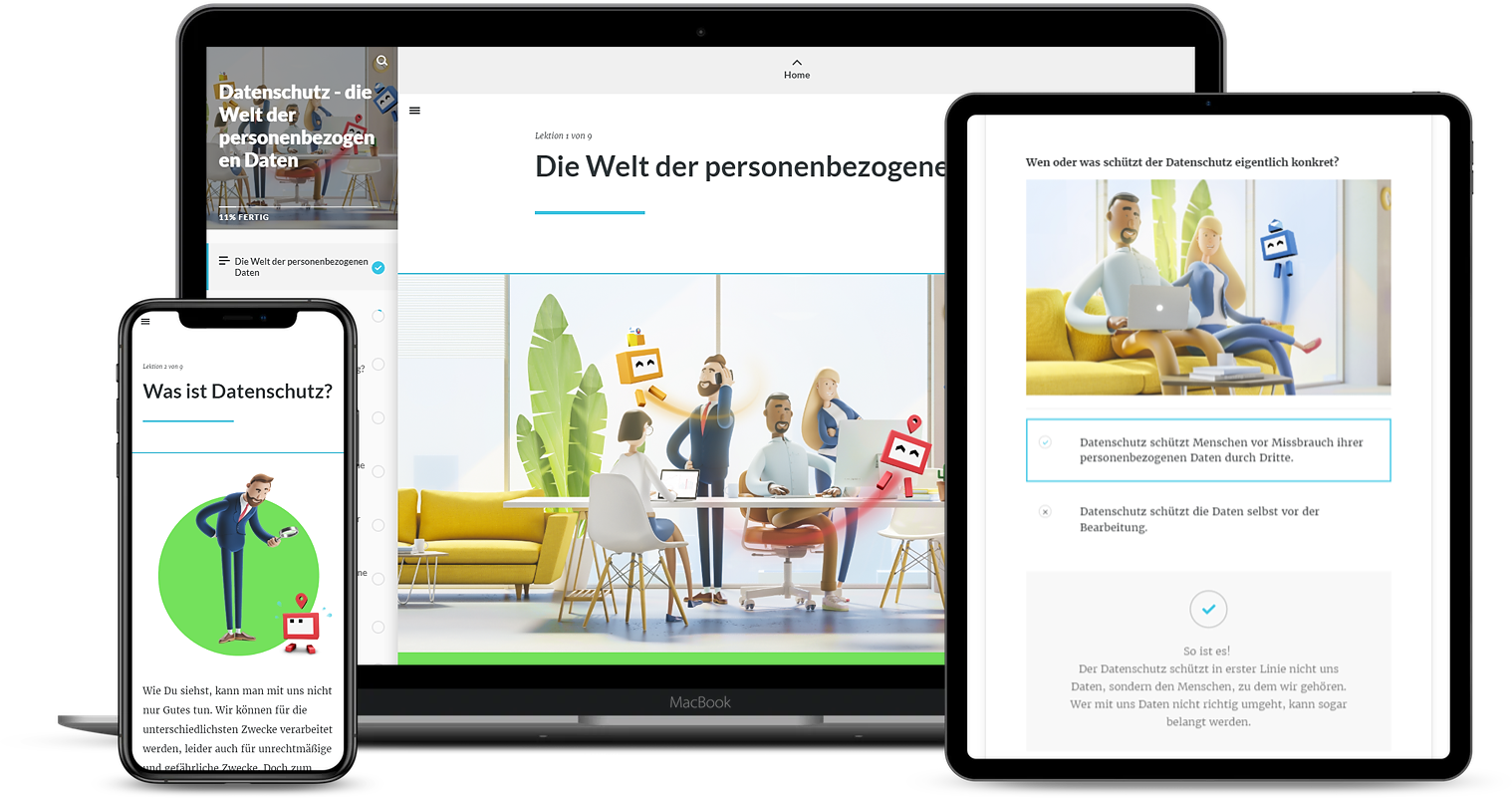
LMS integration
Training alone is not enough – whether based on customised or standard content. Traceability must also be ensured. This is best done with a suitable LMS that allows admins to allocate relevant training courses to each target group, and should also include setting end points and establishing escalation management.
Say, for example, insurance expert Ms Smith belongs to a group of employees who must earn a specific number of IDD points . The administrator can create an automated alert for relevant courses in the system. If she fails to complete the training by a certain date, she will receive repeated email reminders. At a pre-defined date, her direct supervisor can also be informed.
INFO
Since 2018, all insurance intermediaries throughout Europe have been obliged to undergo further training within the framework of the Insurance Distribution Directive (IDD). The number of obligatory training hours varies from country to country.
What to base your choice on
What should clients pay attention to when buying compliance training? Sven R. Becker summarises:
1. First of all, understand your target group. Does the target group need to acquire in-depth specialist knowledge? Or is sensitisation the primary goal? Your answer to this question must be reflected in the technical presentation.
2. It is generally advisable to establish a basic understanding for sensitive topics across the entire organisation, a compliance mindset. Each training course and each measure must be positioned within this mindset. It is crucial that management is setting an example. Integrating senior management into the training course is often helpful, and asking them to design realistic case studies can help learners see how the content applies to them.
3. Standard training is better suited to content more general in nature, as the provider must ensure that it is up to date. However, if a topic is specific to a sector or even just the company, it helps to customise at least parts of the training and only filling the gaps with standard content.
4. Ask yourself for how long you want to use a training course. If contents requires frequent adaptation, OTS content is often a better choice – provided that certifications and updates are guaranteed.
5. Don’t call it compliance training! The term alone is like a red flag for many employees. It pays to be brave and find a different name. Surprise your learners with training courses that polarise and stand out. This makes your contents more memorable than with run-of-the-mill courses. And maybe you can even have your employees enjoy the training – without the yawns.
Further information
If you would like to learn more about off-the-shelf content or our custom content, please check the related pages and feel free to contact us.
You can also check this webinar recording (German only) about the topic of compliance.
Contact
I have been working in the Marketing & Communication Team at imc since March 2019.
Communication, creative content and social media are my passion. "KISS - Keep it short and simple" is my credo.
To explain complex content in an understandable way and thus make the topic of e-Learning accessible to everyone is an exciting challenge every day.
Privately I love to read, play poker and travel a lot.
I am always happy to receive feedback or suggestions.

Punky Talk #4: Dr. Fabian Kempf
The specialist for virtual classrooms firmly believes: “Poorly modelled 3D avatars are not helpful in the virtual world.”
Our fourth Punky Talk is fully dedicated to the topic of virtual classrooms. After all, digital lessons are the best answer to the corona pandemic and the associated prohibition of contact in many places.
The article “Rock 'n' roll in the (virtual) classroom” already examined in detail what a virtual classroom is and how it works. It then goes on to present three providers of virtual classroom tools. Vitero is one of these providers. The highlight of the Vitero software is its user interface. It depicts a meeting room of sorts which is based on the real world and arranges lesson participants around a conference table. Nevertheless, Managing Director Dr. Fabian Kempf firmly believes that poorly modelled 3D avatars are not helpful in the virtual world. In this interview, he shares his tips for adding opulence and glamour to the virtual classroom instead.
Enjoy watching!

To watch this video, marketing cookies must be accepted. Click on the play button to accept. You can find more information in our cookie banner and in the privacy policy.
Summary of key points from the interview
- Virtual classrooms can help companies through the difficult corona period, and even save them from bankruptcy.
- Since speed is paramount, Vitero had to adapt its processes and launched a quick-start offer specifically tailored to the current situation.
- The crucial element for developing a close teacher-student relationship is regular exchange, rather than physical proximity.
- Trainers should therefore focus on interaction and collaboration to strengthen the relationship.
- Good training allows a trainer in the virtual room to respond to common complaints like “I cannot hear you” with confidence, and design interactive lessons that generate discussion.
- LMS and virtual classrooms are a perfect match. A learning management system with web-based training achieves independence in terms of time, inclusion of a larger target group and longer applicability – the half-life of contents. A virtual classroom removes the need for elaborate content creation. Moreover, live communication means that any comprehension issues can be addressed directly. Combining the two tools creates synergies between their benefits and provides optimal support for the realisation of blended learning concepts.
- Incorrectly modelled 3D avatars are rather difficult to navigate in the virtual room. A more effective approach is to limit 3D content illustration to specific points where this boosts visualisation.
Contact person

![[E-Learning Punk] Digital Fastfood](https://images.im-c.com/wp-content/uploads/2020/07/imc_image_elearningpunk_DigitalFastfood_hero_2020_07_07.jpg)
Digital rebellion in L&D or digital fast food?
Why fast-paced development can quickly rack up costs
“You are what you eat.” “If you have a balanced diet otherwise, you can totally indulge in some fast food once in a while.” “Nothing beats fast food.” – Different food philosophies split our society into camps with endless discussions flooding the internet, social media and TV – just like the digital transformation. The corona crisis is considered a digitalisation driver. Companies are catapulted into the digital future. Digital fast food features heavily on the menu. That also applies to human resource development. Everywhere you look, people are moved from the seminar room to virtual classrooms. How much of the current digitalisation efforts in professional development are really sustainable, though? That was the crux of the online panel discussion on “Digital Fast Food: Gambling Away Successful Digitalisation of Learning?”
On the panel: Four learning gourmets and digitalisation gourmands

Sven R. Becker
His statement:
“Fast & cheap digitalisation clogs everything up, resulting in digital overload without lasting positive impact.”

Bianca Bauer
Her statement:
“By itself, a home office doesn’t define digital transformation, and online videos certainly aren’t enough to create a learning culture.”

Prof. Dieter Wallach
His statement:
“Instead of dishing up digital professional development stew: Leverage user experience design and instructional psychology to create positive learning experiences!”

Marios Karapanos
His statement:
“If your learning diet is otherwise balanced, it’s perfectly OK to grab some digital fast food on the odd occasion.”
The discussion: real learning & solid tips
You can watch the full discussion (GERMAN ONLY!) here:

To watch this video, marketing cookies must be accepted. Click on the play button to accept. You can find more information in our cookie banner and in the privacy policy.
Questions and answers: answers to questions from the audience that haven’t been addressed yet
We enjoyed a lively discussion. In the end, the 45 minutes flew by, making it impossible to answer all the question raised by the audience. We want to take up the thread right there. We asked our experts for further explanations and answers. Here are the results:
Is social learning or social collaboration with tools like Microsoft Teams the “new” informal learning?
Becker: Let’s say: A good camera does not make a great photographer. Similarly, structured social learning most certainly needs more than simply using Microsoft Teams. However, providing a good tool for social learning is the first, important step in the right direction. The professional development organizers must then step up and look into the underlying concepts.
How should teacher training be designed to make the most of the opportunities offered by digital education?
Becker: A great range of excellent offers for teacher-specific CPD is already available. The focus must now shift towards curating this content and structuring it in line with appropriate curricula. This should be handled – and financed – centrally. In the long term, this whole process needs to start one step earlier, as part of the initial vocational training. Digital teaching and learning concepts should really be included in the degree course.
Why not structure professional development like Netflix? That could encourage employees to engage in continuous professional development and keep learning.
Becker: “Netflix-like learning” has been used as a synonym for the necessary change in learning experience for several years now. However, we must be careful not to set entertainment at equal with learning. Especially the side effects of Netflix, like binge watching, are not always useful or desirable for learning. We can learn from Netflix how to create incentive models. But we must also consider that increased consumption doesn’t always mean a better learning outcome. Quite the contrary, in fact: We need to learn the right thing in an appropriate dose.
What does the internal knowledge transfer at Ergosign look like?
Wallach: Ergosign uses various complementary channels for knowledge transfer. Thanks to this diversity, factors like the learners’ individual level of experience can be taken into consideration appropriately. For example, our internal and external specialists utilize workshop formats, live-stream Lunch & Learn lectures to all locations, and run practical kick-starter campaigns for 1-2 days at a time. This provides an introduction to basic topics and progresses to advanced UX design and development. A comprehensive and ongoing Ergosign guide provides answers to (almost) all questions about structures and processes in the company. Finally, onboarding buddies are allocated to each new team member to help them find their feet at Ergosign. After all, a quick chat at the coffee machine is often used as a welcome opportunity to clarify urgent issues.
How can I reach people of different cognitive abilities without making things boring for those starting from a good place?
Karapanos: Differentiation makes it possible. Two possible ways to approach this are to divide the learning group into sub-groups of homogeneous performance or by differentiating internally. Organizing school classes by year or dividing school kids into different forms of secondary education based on interests and achievement is based on the idea of creating sub-groups of homogeneous performance. In some countries, like Germany, kids even need to achieve certain marks to qualify for more ambitious secondary schools. As the examples show, homogeneity is relative. There are, of course, stronger and weaker students within a class, regardless of where the line is drawn. Internal differentiation strives to catch the differences within a learning group by differentiating learning offers according to the difficulty or scope of a task. Both approaches mean more work for teaching staff. For several decades, the hope that this additional effort could somehow be “outsourced” to intelligent adaptive learning systems that automatically tailor the learning path to the learner’s learning potential has persisted. Thus far, realization has been of limited success.
I really need configuration options like personal interface set-ups when using Zoom and GoToWebinar. We often use conferencing tools even though many interaction features are missing. Is a UX revolution our only hope for using it with our colleagues?
Karapanos: We should expect evolutionary development, rather than a revolution. However, UX will play an important role. The basic feature range is comparable across all video conferencing tools. None of them really offers more than the competition. Looking at it pragmatically, the providers are in a quality stalemate. To stand out from the competition, they can leverage pricing and service differences, and emphasize product use quality by addressing specific needs.
We hope this answered your questions sufficiently. Further insights, statements and summaries of the panel discussion are brought to you by the Community under the hashtag #DigitalFastfood. We’re already working on the next instalment. Let us surprise you!
Contact person
